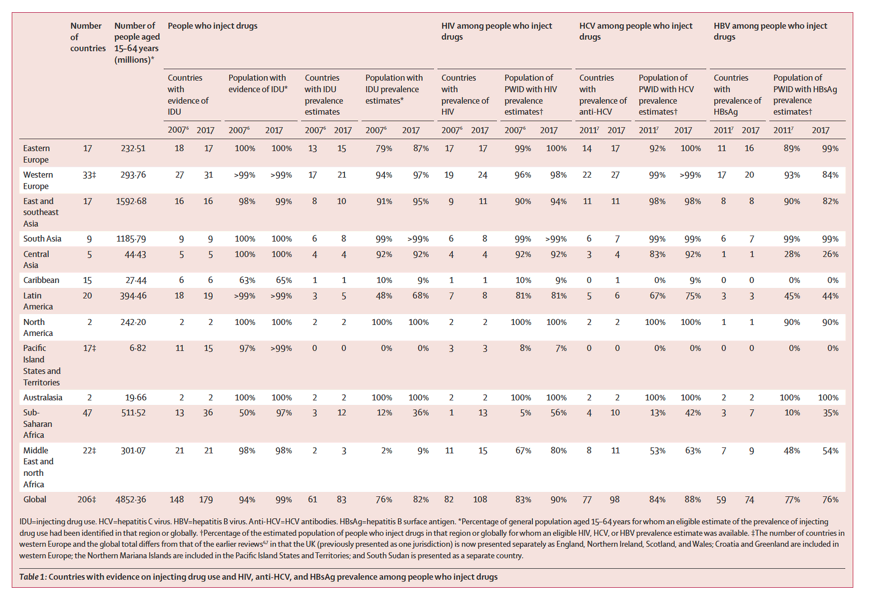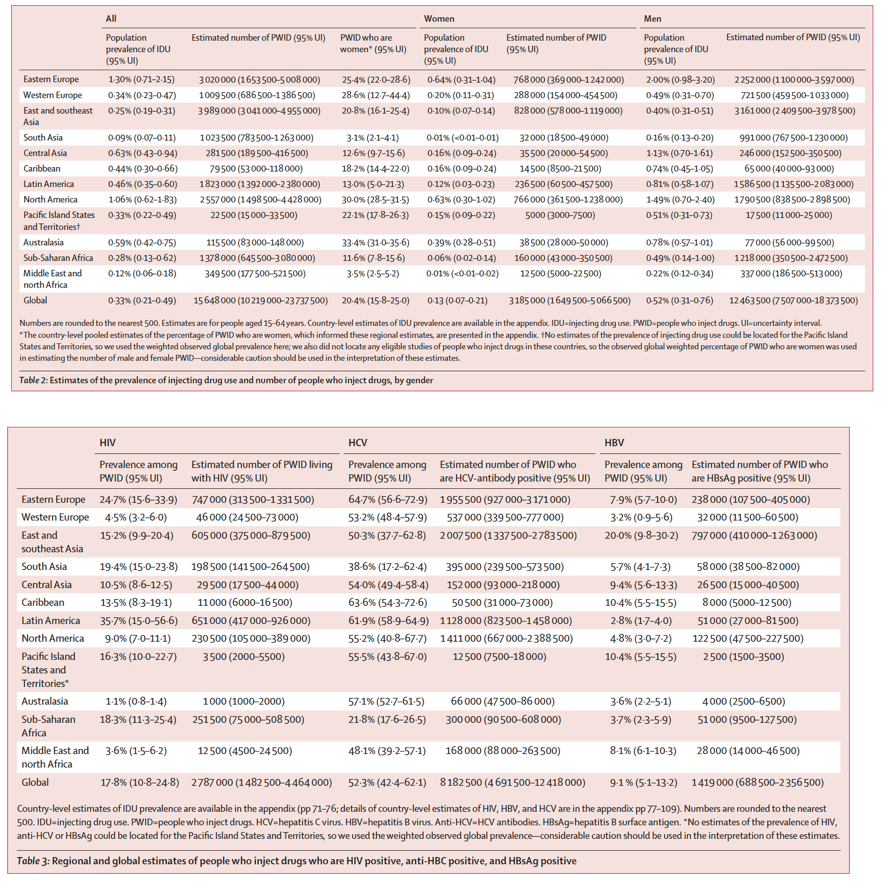| |
Global prevalence of injecting drug use and sociodemographic characteristics and prevalence of HIV, HBV, and HCV in people who inject drugs: a multistage systematic review - 2017
|
| |
| |
Download the PDF here
We estimate the number of PWID globally to be 15⋅6 million and that roughly one in six are living with HIV, more than half have been exposed to HCV, and one in ten have active HBV. We also estimate that most PWID are exposed to environments that increase their risk of drug-related harm, which, to our knowledge, is the first such global estimate.
We estimate that there are 15⋅6 million (95% uncertainty interval [UI] 10⋅2-23⋅7 million) PWID aged 15-64 years globally, with 3⋅2 million (1⋅6-5⋅1 million) women and 12⋅5 million (7⋅5-18⋅4 million) men. Gender composition varied by location: women were estimated to comprise 30⋅0% (95% UI 28⋅5-31⋅5) of PWID in North America and 33⋅4% (31⋅0-35⋅6) in Australasia, compared with 3⋅1% (2⋅1-4⋅1) in south Asia.
(2017) Globally, we estimate that 17⋅8% (10⋅8-24⋅8) of PWID are living with HIV, 52⋅3% (42⋅4-62⋅1) are HCV-antibody positive, and 9⋅1% (5⋅1-13⋅2) are HBV surface antigen positive; there is substantial geographic variation in these levels. Globally, we estimate 82⋅9% (76⋅6-88⋅9) of PWID mainly inject opioids and 33⋅0% (24⋅3-42⋅0) mainly inject stimulants. We estimate that 27⋅9% (20⋅9-36⋅8) of PWID globally are younger than 25 years, 21⋅7% (15⋅8-27⋅9) had recently (within the past year) experienced homelessness or unstable housing, and 57⋅9% (50⋅5-65⋅2) had a history of incarceration. https://www.thelancet.com/journals/langlo/article/PIIS2214-109X(17)30375-3/fulltext
Globally, in 2015 an estimated 15⋅6 million people (95% UI 10⋅2-23⋅7 million) injected drugs, amounting to approximately 0⋅33% (0⋅21-0⋅49) of those aged 15-64 years (table 2; detailed country estimates are given in the appendix (pp 72-78). We estimated that 3⋅2 million (1⋅6-5⋅1 million) women inject drugs globally.
Russia, the USA, and China contributed the largest proportions of the total IDU population.
We estimated that 9⋅1% (95% UI 5⋅1-13⋅2) of PWID have chronic HBV infection (HBsAg positive), equating to 1⋅4 million (0⋅7-2⋅4 million) people. The region (table 3) with the highest estimated HBsAg prevalence among PWID was east and southeast Asia, although countries with the highest prevalence also included the Czech Republic, Egypt, Belarus, Lithuania, the Côte d'Ivoire, and Azerbaijan (figure 5; country estimates and details are provided in the appendix pp 104-112). We estimated that PWID in east and southeast Asia represent more than half of all HBsAg-positive PWID worldwide (table 3).
Opioids were typically the main drug injected (table 4). The country with the lowest percentage of PWID reporting opioids as their main drug was the Czech Republic (21⋅6%, range 17⋅3-26⋅3; appendix pp 113-57). Higher proportions of PWID had stimulants as their main injected drug in countries in North America, eastern Europe, and Australasia (table 4). The pooled percentages of opioids and stimulants could exceed 100% because different studies could be included in the opioid versus stimulant pooled estimates, and in some countries, PWID reported that a combination of opioid and stimulants (eg, so-called speedballs) was their main drug injected.



------------------------------
|
|
| |
| |
|
|
|